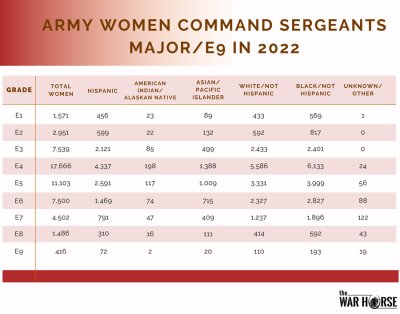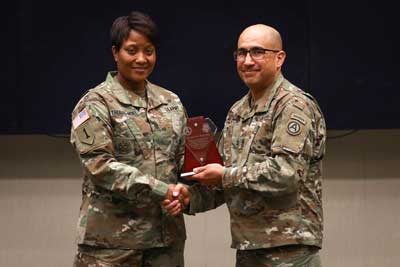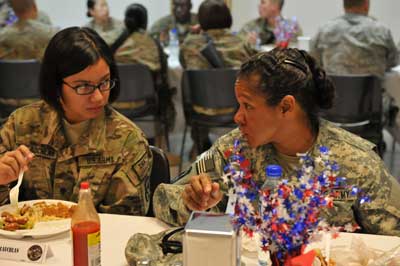Command Sergeants Major Built a Culture of Camaraderie, as Soldiers and as Black Women
Eden Stratton and Anne Marshall-Chalmers
Melissa Jones never thought she would join the military. Hailing from Brooklyn, New York, she planned to go to college as a full-time student. Her life changed when an Army recruiter appeared at her front door—looking not for her, but for her brother. He wasn’t home, but Jones’ mother let him in.
“My mom and I sat, and we listened to the recruiter’s spiel about giving back to your country, serving, traveling the world, and getting college money,” she says. “After he left, I gave it some thought. And a few days later, I went down and took the ASVAB.”
Throughout her military career—which spanned 26 years—she traveled the world, mentored countless troops, and deployed to Kuwait in 2010, where she served as a medic.
Jones retired as a sergeant major—one of the Army’s top-three enlisted ranks.
But despite her accomplishments, her superiors scrutinized and underestimated her, she says.
“When I first started, it was a good old boy system, as we would call it,” Jones says. “So all of your senior-ranking individuals were older white men—so it was difficult.”
Jones wasn’t alone. She and the other enlisted women forged a unique and unbreakable bond, she says.
“It was just kind of like, ‘Girl, you made it to [sergeant] major. I’m impressed because I know what you had to do to get here,’” she says. “It’s the unspoken feeling or thing that we share.”
As of October 2022, 416 women were serving as command sergeants major, the Army’s highest enlisted rank, according to U.S. Army Human Resources Command. Of those, nearly half—193—were Black women (who don’t also identify as Hispanic), the most of any group. But Black women make up just 36% of enlisted women in the Army.

Despite making up just 36% of the women in the U.S. Army, Black women soldiers make up almost half of women command sergeants major. Graphic by Kelly Kennedy/The War Horse.
In an organization where the officer corps is mostly white, these women often serve as mentors, both to the young women who follow in their footsteps and to the young officers who depend on their guidance to lead soldiers.
While enlisted soldiers can join the Army straight out of high school, the officer ranks require a college degree. Of 16,013 women Army officers, 9,353 are white and 2,892 are Black. And 21 white women and two Black women served as general officers in 2022.
The number of white women who graduate with an associate’s degree by the age of 29 is almost twice as many as Black women, according to the Association of University Women. That comes as disparities continue to exist in the university and economic systems—a recent New York Times story highlighted the lack of economic diversity in the nation’s top schools, saying the disparity had less to do with the academic abilities of students and more to do with their families’ income levels.
Lynice Thorpe-Noel, who recently retired as a command sergeant major, says one reason she, and perhaps other women of color, chose to stick with the Army is that no matter what life threw her way—marriage, kids, divorce—a career in the Army offered opportunity to ascend to positions of leadership, and, perhaps even more importantly, it provided stability.

Command Sgt. Maj. Lynice D. Thorpe-Noel, the senior enlisted adviser for U.S. Army Human Resources Command, receives an appreciation gift from Sgt. Maj. Roger Rendon, the human resources senior enlisted adviser, U.S. Army Central, during the Women’s History Month observance ceremony on Shaw Air Force Base, South Carolina, in 2019. Thorpe-Noel told a group of Army women that she faced discrimination based on color and gender, but watching other women succeed helped her. Photo by Sgt. Von Marie Donato, courtesy of the U.S. Army.
The proportion of Black women recruits in the Army is significantly higher than in the civilian workforce, according to a report by the Council on Foreign Relations, a nonpartisan think tank based in Washington.
“I know for me, as a woman, one of my big things is how am I going to be secured?” she says, adding that her approach was always, “as long as I’m moving up, I’m staying.” She became the first woman to serve as the senior enlisted adviser for the U.S. Army Human Resources Command.
While Black women are less likely to reach the top levels of the commissioned officer ranks, their numbers in the enlisted ranks mean they fill top advisory and mentoring roles. The first sergeant—a top enlisted position on the way to becoming a sergeant major—is often the first person an enlisted soldier meets at a new unit. They are the top leaders soldiers are most likely to see on a daily basis. And because enlisted noncommissioned officers—say a first sergeant at the company level—usually have more years of experience than officers at the same level—say a captain at the company level—they often provide guidance to those younger officers.
Award-Winning Journalism in Your Inbox
It also means they can provide an example and guidance to young women of color.
Black women sergeants major say they’ve built a culture of camaraderie, both as soldiers and as Black women. Organizations like the National Association of Black Military Women have made it their mission to continue fostering those relationships, and “to seek out, record, maintain, and tell the history and heritage of African American Military Women who served and are serving in the United States Armed Forces.”
For veterans like Jones, the sisterhood she found forged lifelong friendships.
“We’d always find each other—you’re in that crowd and you’re looking for someone who looks like you, sounds like you, that you believe you can relate to,” she says. “Although we were far and few in between, we seem to find each other.”
‘My Position Was to Empower’
Despite the military’s increase in overall diversity, women make up just 17% of the total armed forces, with only 10 women ever achieving a four-star rank. There were 3,067 male command sergeants major in October. (About a quarter of them, 763, are Black men.) But mentorship among Black women, the women say, allows them to make vital connections and navigate interpersonal interactions laced with racist stereotypes.
Retired Command Sgt. Maj. Donna Brock remembers such interactions, as well as the strategies she relayed to her fellow servicemembers. She served for 35 years in the Army as a medic, drill sergeant, and recruiter, before rising through the ranks to command sergeant major.
“My position was to empower and to uplift everyone—if you had the propensity, if you had any kind of leadership skills and the potential to move up, then [you] should be doing that the same across the board,” Brock says. “Now, we all know that doesn’t happen. I mean, let’s be real. Humans are humans, people are people, and some pick and choose who they pick.”
The most impactful part of her position was empowering women, first and foremost, she says, and second was empowering women of color. In a unit with primarily men as commanding officers, Brock realized that to uplift unheard voices, she had to become the example women were searching for.
“Men look at you like there’s something wrong with you—you have an ‘attitude,’” she says. “What I would try to do is ensure that women knew that you have got to be able to overcome that, and show that it’s not attitude, it’s more of your self-esteem.”
Throughout history, Black women have worked to increase diversity and equity in the military. Cathay Williams was the first Black woman to serve in the military, posing as a man to fulfill a three-year contract with the Union army. In 1866, she would join the 38th U.S. Infantry Regiment and would travel throughout the West as a “buffalo soldier.”
During World War II, the Army created the Women’s Army Auxiliary Corps to assist with operational capacity, offering skills training and some benefits. In 1940, the War Department desegregated the military, and by the war’s end, about 6,500 Black women enlisted. When they realized they would be subject to menial labor and discriminatory practices instead of the promised training, they went on strike—forcing the War Department to acknowledge their integral contributions to the war effort. Their determination would lead to better treatment and eventual integration of Black WACs.
Black women continued to provide support during the Vietnam War, serving as nurses and intelligence personnel. Doris “Lucky” Allen served in intelligence work, and her analysis was often found to be correct, despite being ignored for being “Black, WAC, intelligence, ‘Spec-7,’ and enlisted.” She retired in 1980 and was the first Black military woman to be inducted into the Intelligence Hall of Fame.
During the Persian Gulf War, Black women continued to be an integral part of the military’s forces, making up 40% of 35,000 women serving in combat. Upon the onset of the War on Terror, 254,000 Black Americans served in the Army as active-duty, Reserve, or National Guard soldiers, or as Army civilians.
‘I Have Another Guy in Mind’
Despite the contributions of Black women in the military, stereotyping and discrimination continue to follow them as they rise through the ranks, they say. Jones recalls her promotion to first sergeant, in which her new sergeant major was visibly confused that she, a Black woman, was the one filling the position.
“I remember walking into the office of [the man] who was going to be my boss, and he was a sergeant major—an older white man,” she says. “I walked into the room and introduced myself, ‘I am Master Sergeant Jones. I’m here for the first sergeant position.’ And his response was, ‘No, you’re not.’
“In my first sit-down with him, he said, ‘You know, it’s OK if you are not cut out for this job. I had another guy in mind. So if you want to take the senior NCO medic position, I can move you to that position and put him as the first sergeant.’”
She felt confused and was fuming, she says. After all the training, the instructing, and being top of her class, she was still underestimated and undervalued.
“Nope,” she remembers telling him. “I got it.”
Brock felt similarly, she says.
“We had to work double and triple harder than the males,” she says. “Especially in the medical world where I was, there were [a larger number of] women—as opposed to in some of the other areas of the Army, different jobs. Even though there [were] more women, we still had more men. We were still out.”
Thorpe-Noel says she too occasionally felt the sting of prejudice during her 31 years in active duty, especially when she was a younger soldier who didn’t “see anybody who looks like me— women that were out there at those senior ranks,” she recalls. But it’s important to note that “most of my opportunities came from people that didn’t look like me,” she says.
‘They Have to Know There’s Nothing They Can’t Do’
While discrimination and difficulties persisted during their service, the mentorship among Black servicemembers made a profound impact on their experience and careers, Jones and Brock say. Jones remembers her days as a trainee and the Black sergeant major who helped her adjust to Army life.
“It was a lady named Sgt. Britt,” Jones says. “I was a young little hothead. When I was in Maryland, I was a good soldier. But, I still had a lot of mouth, I had opinions. When I thought something was stupid or dumb, I would always tend to say, ‘I think this is stupid or dumb,’” she says, laughing.
“She pulled me aside and pretty much said, ‘That’s not gonna get you anywhere. That’s not going to help you with your career. If you’re looking to make this a long-term thing, you gotta cool it on that, and there’s a way to go about it. … She taught me how to navigate and approach situations in a way that was going to still make my point come across, but not have folks feeling attacked.”

U.S Army Spc. Hannah McLauchlan, a San Antonio, Texas, native, with the 440th Medical Detachment (Blood Support), talks with U.S. Army Command Sgt. Maj. Donna Brock, the U.S. Army Medical Command senior enlisted adviser to the Army surgeon general, in 2012, at Bagram Airfield in Afghanistan. Photo by Capt. Abbie Leonhardt, courtesy of the U.S. Army.
Brock recalls a mentor of her own—a strong “bulldog” of a woman who became a role model for her during her early years in the military.
“She was mean, she didn’t care what nobody thought, but you know, I looked up to her,” Brock says. “Because, I said, ‘Man, you know what, she is strong.’ That was when she was a staff sergeant and I was like a little E4 specialist, looking at who could mentor me or I can watch and learn from them.”
The two kept in touch for years afterward, and today Brock recalls her fondly. She says the camaraderie among women of color is integral to the military’s development.
“The importance of fostering these relationships is because you have to have the diversity out there,” Brock says. “You have to be able to show women that they can do the job, they have to grow their confidence, they have to grow their self-esteem.
“They have to know that there’s nothing that they cannot do.”
‘She’s My Success Story’
Jones continues to mentor and support Black women in the military despite retiring. A member of NABMW, she finds connection and friendship within the organization. Once, as a first sergeant in the Army reserves, she noticed a young woman reservist lingering after a training session. She seemed nervous, Jones says.
“One day, we’re all leaving on Sunday, and she was just kind of lagging around, and I brought her into the office,” Jones says. “And I [asked], ‘Is everything all right?’ She was like, ‘Well, I was wanting to ask you if there was an opportunity for me to do more days. Could I stay on and work through the week and make a little extra money?’”
As the conversation progressed, the soldier opened up. She had lost her job, and was living in her car with her nine-year-old daughter.
“As first sergeant, you are the first line of connection—you are a parent, you are their chaplain, you are their counselor,” Jones says. “I was able to get her linked up with a local church, get her some military counseling, [and] get emergency relief funds through the military to get her set up.”
Our Journalism Depends on Your Support
The soldier eventually moved to Massachusetts and began to get back on her feet. She started a small business, and her daughter enrolled in college. She’s running for a political position, and Jones still feels proud of her to this day, she says.
“She’s my success story,” Jones says. “It almost brings tears to my eyes to think about her.”
The things that made them different from everyone else helped them connect on a personal level, Jones says.
“The idea that when we walked into the room, we were different, we stood out, and many times not received properly—not received at the level of knowledge and experience that we brought to the table,” Jones says. “A lot of times we were hushed, or put on the back burner, or dismissed.
“Even if the culture has changed in that they feel more welcomed, and they don’t get that look … I can guarantee you there’s still a moment of where being a woman of color is different in the military, for their counterpart,” she says. “And we’re there to support them through whatever that moment may be.”
Brock says she’s watched—and helped—women rise, but there still are not enough women in positions of leadership. The reaching back down and lifting each other up, the mentoring, is key.
“It’s getting better but it’s still not there, and I think that’s what is needed.”
This War Horse investigation was reported by Eden Stratton and Anne Marshall-Chalmers, edited by Kelly Kennedy, fact-checked by Jasper Lo, and copy-edited by Mitchell Hansen-Dewar. Headlines are by Abbie Bennett.





Comments are closed.